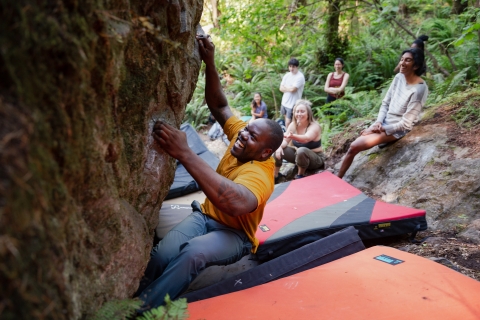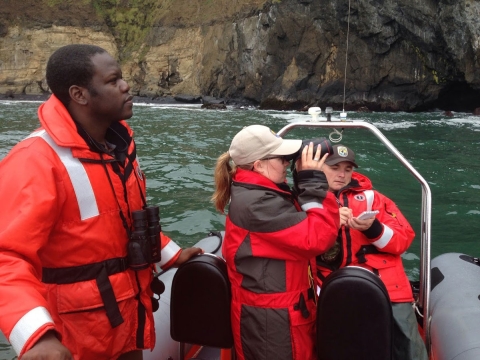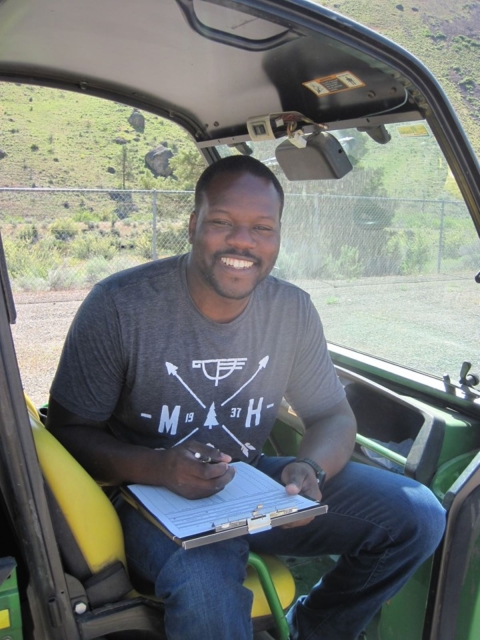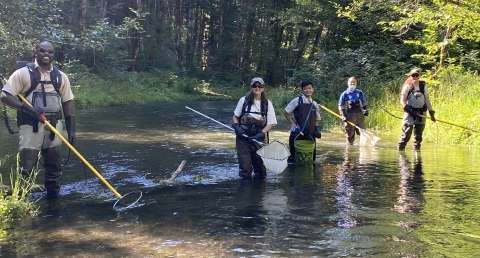Rikeem Sholes may be one of the busiest and most versatile people you’ll ever meet. A fish biologist and licensed drone pilot for the U.S. Fish and Wildlife Service, he tells you that he spends his workdays spying on salmon – using technology to track fish for numerous projects in the Columbia River Basin.
Outside of work, Sholes is working on his third academic degree – a Ph.D. in the Coffin Lab at Washington State University, studying how hatchery conditions affect the development of mechanosensory systems in Chinook salmon. Put more simply, he studies fish hearing. If all that weren’t enough, he is an avid rock climber and administrator of PDX Climbers of Color, a network of over a thousand rock climbers in the Portland area aiming to break social and economic barriers to provide equal access to climbing.
Growing up in the inner city of New Orleans, Sholes did not have personal connections to people in the conservation field. But he had a role model that many of us share – Sir David Attenborough, the world-renowned naturalist and one of the most recognizable voices in conservation. Sholes watched Attenborough documentaries religiously, allowing him to gain exposure to a field that he did not have direct access to. This exposure, he says, was pivotal for him when it was time to choose a field in college.
“He was my biggest role model,” Sholes says definitively about the famed broadcaster.
Exposure is important. Much of what Sholes does now in the outdoors both in his personal and professional life, he was only exposed to in videos and images growing up. He always knew biology would be his path. It was one of the few things he knew he could do every day and all day.
Today, Sholes works out of the Service’s Columbia River Fish and Aquatic Conservation Office in Vancouver, Wash. A Navy Veteran, he started with the Service in a temporary position in 2016 and was hired on permanently in 2017.
Sholes’s first job with the Service was working with seabirds and habitat restoration, which gave him the opportunity to work on Midway Atoll in the northwestern Hawaiian Islands. During his time in this role, his team was assigned to respond to a botulism outbreak that threatened one of few remaining populations of Laysan teal, a small, endangered duck.
Sholes was one of three volunteers that summer who successfully found, treated, and rehabilitated sick teals; the days were hot and spent shin-deep in duck ponds that smelled of methane. Yet still he recalls, “I didn’t have a bad day that whole summer.”
In this effort, Sholes realized how a small but mighty team of only three people with motivation and skill can make a real impact on a whole population of wildlife.
“Small groups of people can still make a difference,” he says. “That’s what really taught me that it doesn’t take a lot of people to have a huge impact.”
After his experience on Midway, he knew he wanted to stay with the Service.
“I knew that I would be part of an organization where we would not only be doing science, but we would also be doing actionable science.”
It was important to Sholes that the science conducted in the Service has real-world implications.
Sholes finds joy in that outdoor conservation work often requires “MacGyvering,” as he puts it, being out in remote areas with duct tape, cobbling things together. He has been able to transfer skills from making a ship work on deployment with the Navy to making his experiments work in the field as a biologist. Sholes talks about how his experience in the military raised the bar of what was “difficult” for him. So even if the days are hard in the field, they are never as hard as they were in the Navy.
Now approaching nearly a decade with the Service, he points out, “The one thing that I’ve noticed in the U.S. Fish and Wildlife Service is that you rarely meet someone who doesn’t love their job. That’s huge for me – to be around so many people who are passionate about their jobs.”
And Sholes is undoubtedly one of those people. He applies his wide-ranging skillset derived from many different life experiences to his work in so many ways. He sees the possibilities both inside and outside of the box – that his past experiences learning to problem solve and use technology has made him nimbler and more versatile in the work he does now.
Beyond the work he does in the field, Sholes also understands he can be a role model for others and facilitate that important exposure to the world of conservation.
“Part of my work is making sure people who look like me realize that this work is a possibility for them.”
Until recently, there was not a lot of representation for people of color in his field.
“I want to make sure that at least part of my story is that other Black children specifically, but people of color in general, know that there’s a great career path here. If I can help to mentor some other people so that they can do some science that has a real impact, I’ll feel like that’s an accomplishment.”
About the time when Sholes was beginning his career with the Fish and Aquatic Conservation Program in the Pacific Region, Assistant Regional Director Judy Gordon took on the role to lead the entire program for the region.
Gordon has a decades-long career in fisheries and leadership under her belt, and Sholes thought about what she must have gone through over her career – to see her go as far as she had, especially in times when there were fewer Black people and women doing it, made it feel possible to him.
“Meeting another Black biologist was like seeing a unicorn,” Sholes remembers. And before working in the Service with his colleague Nicole Hams, he says that it had been seven years since he worked in any proximity to another Black biologist.
“I feel like that’s a shame,” he says.
As much as Sholes has loved his journey, there were some challenging times when he was the only Black person out working somewhere, trying to repair a flat tire in a remote area, or finding a fix for an experiment gone wrong; sometimes being the only person of color or alone in a rural area, he had worries beyond just fixing the issue. In these hard moments, sometimes he’d think he could be doing something else. But now, seeing possibilities through Gordon’s experience helps him through.
“Seeing that someone was able to stick it out and is doing well for themselves in this industry is an inspiration for me. All it takes is one person to make it. If one person could make it, we can all make it.”
Sholes has enjoyed his role as a versatile, tech-savvy fish biologist who can implement quick solutions in the field and fly a drone to spy on salmon. For the near term, he would like to finish his Ph.D., and he continues to work on longer-term goals, perhaps to someday lead a whole team of people with expertise in technology and electronics.
Along his journey, Sholes has gained many insights and wisdom. What advice would he give to his younger self or others coming up in conservation?
First and foremost, “Don’t be so hard on yourself.”
Have an open mind: “Be open to a lot of experiences.” Sholes says that going into his career without too specific a goal helped him to experience many different facets of what it meant to be a biologist. There was value gained from all those experiences, building the foundation for what he is doing now.
Take some risks: “Have a rough plan of where you want to be, but take some risks here and there and you’ll be surprised where it will take you.”
Be flexible: “Don’t be rigid. You can plan, but life may have a different idea.”
Believe in the product: “You’re never going to be able to put your whole heart into something unless you believe in what you’re doing there.”
Choose what you love: “If you have the ability to, choose to do something that you love. I couldn’t come to work every day just for a paycheck. It adds so much to my life and to specifically my mental health that I’m able to do something that I enjoy every day.”








